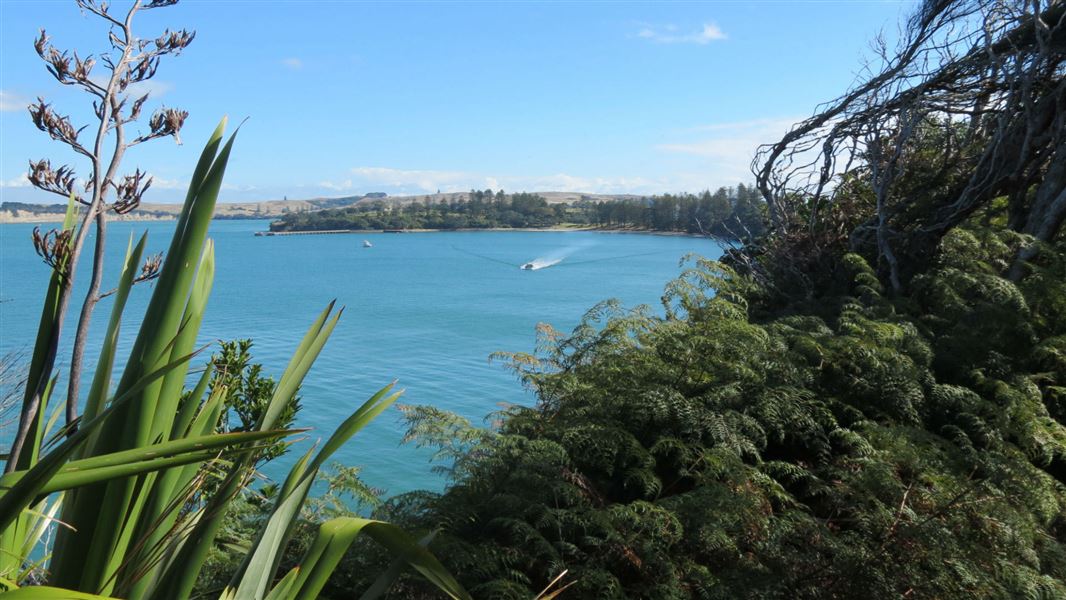Just 45 minutes from downtown Auckland, the varied history of Motuihe Island / Te Motu-a-Ihenga includes being extensively settled by Maori, and farmed by Europeans for more than a century.
It was the site of Auckland's quarantine station for 50 years, a prisoner of war camp, and a naval training base.
Video
Brochures
Motuihe Island/Te Motu-a-Ihenga is in the Hauraki Gulf near Motutapu and Waiheke islands.
Access is by ferry, private boat, water taxi or kayak.
Public passenger ferry and private charter
Over the summer months Red Boats run regular services to Motuihe. Motuihe Island Ferry Auckland | The Red Boats
- From late December to end of January Red Boats run regular ferry services (timetable to be announced in December 2024).
- From February to Easter Red Boats run a service every Saturday and Sunday.
- Private charters to Motuihe Island are also available.
If you are chartering a commercial vessel to the island, check the operator has a Pest-Free Warrant. Commercial vessels that use the wharf will also need a wharf landing permit.
Find authorised transport operators to this island.
Private boat
If arriving by private boat, there are several safe anchorages including Wharf Bay, Ocean Beach and Calypso Bay. Note that the wharf is only available for dropping off and picking up passengers.
Kayak
The island is accessible by experienced kayakers. It takes approximately two and a half hours to kayak to Wharf Bay. Several kayak operators offer kayak rentals and guided kayak tours.
- The historic water tower is a major hazard, and the site is fenced off. Do not enter the inside of the perimeter fence or the tower.
- Bring your own food and drink. The Motuihe Trust opens the 'kiosk' near Ocean Beach on busy weekends, selling drinks and ice creams. There are no other shops on the island.
- Wear good walking shoes.
- Slip hazard – take care on the boat ramp and wharf which are often slippery.
- Bring insect repellent for sandflies.
Rules for the Hauraki Gulf Maritime Park
- Fires and portable barbeques are not allowed.
- Take your rubbish with you – there are no rubbish bins.
- Some activities such as weddings need a permit.
- No camping.
These are part of the Hauraki Gulf Maritime Park by-laws. Read the full by-laws.
Alongside its sheltered white sandy beaches, Motuihe also boasts rocky platforms, native forest and rolling pasture.
The island is free of animal pests and is home to the endangered New Zealand dotterel, saddleback, kakariki, kiwi, shore skinks, bellbirds and tuatara.
Community conservation
The Motuihe Trust is running a restoration project in partnership with DOC, with the aim of reforesting parts of the island, returning native birds, lizards and insects, conserving historic features and developing tracks and visitor facilities. Since 2003 volunteers have grown and planted thousands of trees on the island.
The Motuihe Trust have released a number of rare species onto the island including North Island Saddleback (tieke) in 2005 followed iby kakariki (red-crowned parakeet) in 2008 and shore skinks the following year. Little spotted kiwi were released in 2009 and 2010, and bellbirds were returned to the island in 2010. In March 2012, 60 tuatara were released onto the island, from Lady Alice island in Northland. Rare plants are also being returned to the island as part of the planting programme. These have included shore spurge (also known as euphorbia) and a rare fireweed.
The reintroduction programme will continue over the coming years. Some species may return naturally as the planting programme progresses. This is only possible because the island is free of mammalian pests. DOC eradicated Norway rats and mice in 1997 and cats and rabbits have also been removed. Visitors to the island are asked to help keep Motuihe free of pests and weeds so these species can thrive.
Motuihe's shores are also home for two threatened shorebird species, the NZ dotterel and the variable oystercatcher. Little blue penguins also breed on the island.
Motuihe Island/Te Motu-a-Ihenga has a varied history of Maori and European settlement, and was used for quarantine and military purposes. Read the history of Motuihe Island/Te Motu-a-Ihenga.
No dogs allowed
To protect our native wildlife, dogs are not allowed anywhere in this place.
Check you are pest-free
Check, clean, and seal your gear to ensure you don't bring pests, soil, and seeds.
| Auckland information | |
| Phone: | +64 7 867 9080 |
| Email: | kauaerangavc@doc.govt.nz |
| About: | Kauaeranga Visitor Centre provides visitor information for this area |
